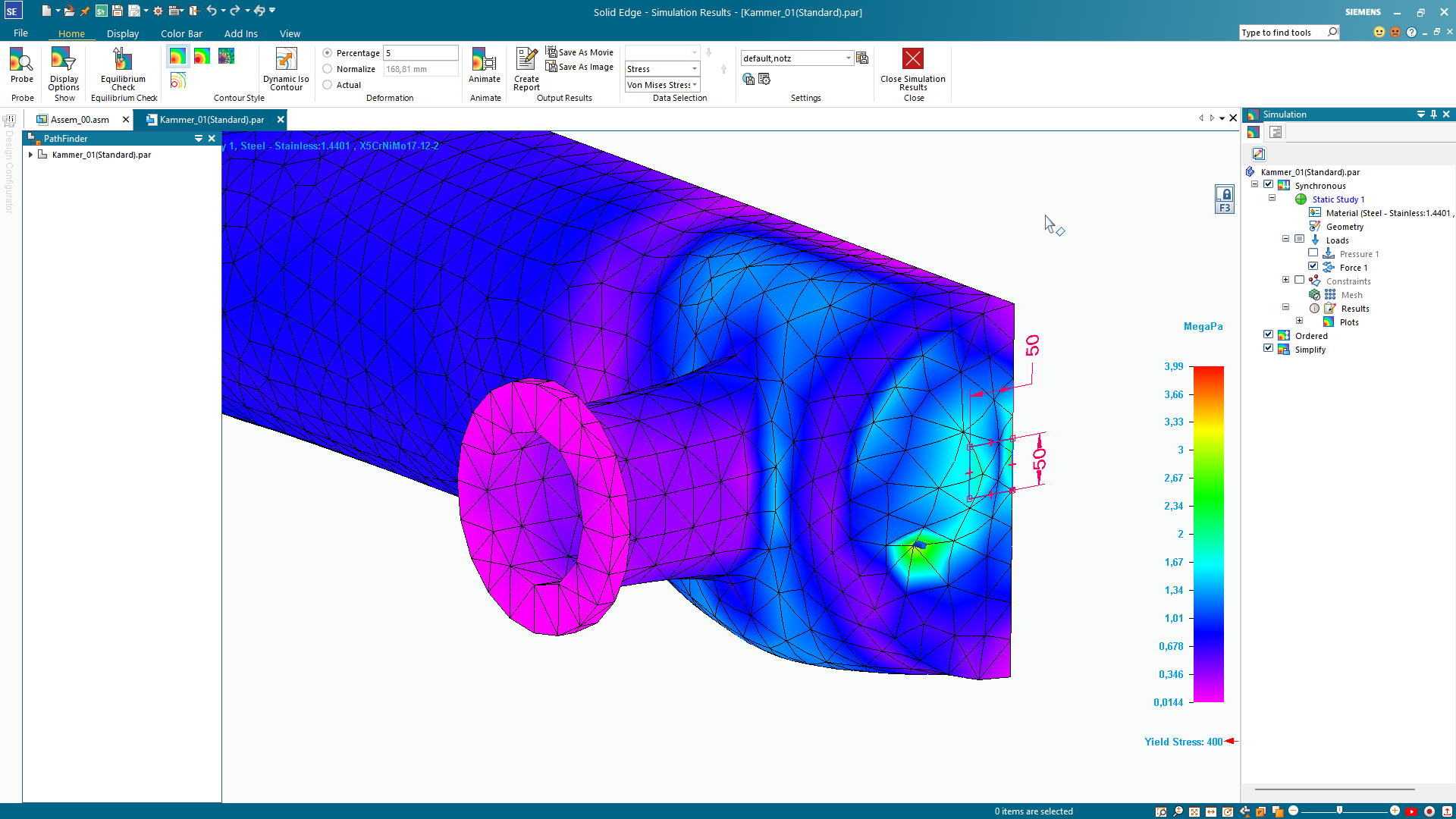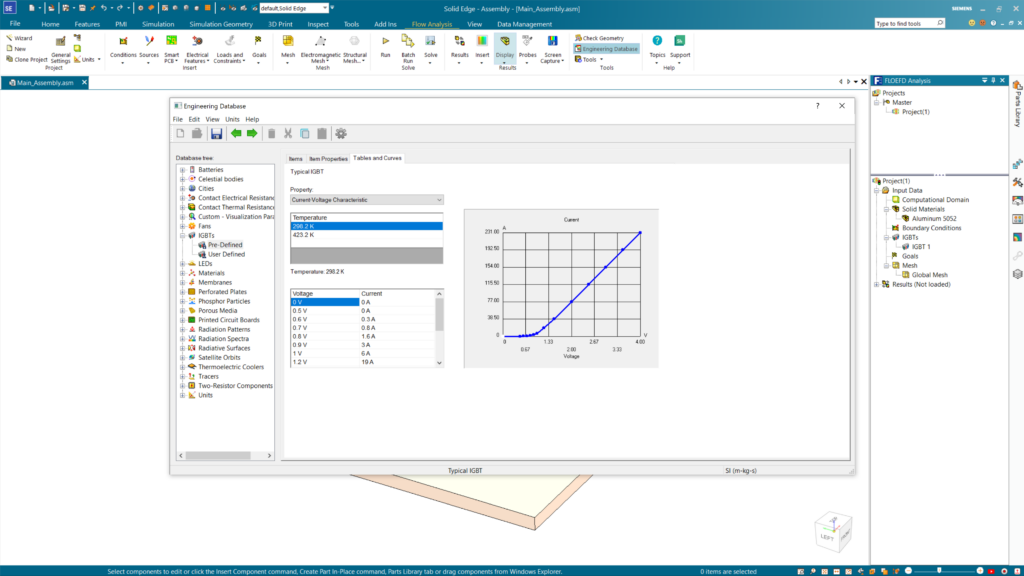New in Solid Edge 2024: Increase simulation speed, performance and reliability

Table of Contents
This year, we’re taking a deep dive into everything that’s new in the Solid Edge 2024 release in a series of blog posts focused on the most noteworthy new features and enhancements. In this post, we’ll cover Simulation enhancements in Solid Edge 2024.
Enhancements in Solid Edge Simulation and Simcenter FLOEFD for Solid Edge increase simulation performance and speed with improvements to meshing, structural analyses and interoperability. The new IGBT compact model makes it easier to incorporate electronic components into your simulation studies, while the Cartesian Mesh Generator and improved mesh quality checks enable faster meshing and simulation workflows, resulting in two to three times faster meshing speed.
Solid Edge Simulation
Increased interoperability enables Solid Edge Simulation users to import solid temperature results from a Simcenter FLOEFD for Solid Edge study. A new command within the Solid Edge Simulation “External Loads” option, “Import Solid Temperature” is now supported in addition to the previous “Import Fluid Pressure” and “Import Fluid Temperature” commands. This command is available only with Linear Static studies and is useful to find thermal stresses and deformations in solids.
The new option to apply force to any user-defined point allows for greater control of simulation studies. The option has been added to the Force command bar, allowing users to apply forces to any 2D or 3D point on the geometry, increasing capabilities alongside the traditional “Point” option which supported the selection of vertices.
The display of mesh quality checks has been improved to make it easier to identify poor quality areas. Now colors are lighter and easier to decipher, and users can increase efficiency by being able to spot mistakes instantly. Users can also change the filled color of failed elements from the “Check Element Quality” dialog for better visibility.
Simcenter FLOEFD for Solid Edge
IGBT compact model and Cartesian Mesh Generator
The Insulated Gate Bipolar Transistor (IGBT) compact model is now composed of an Electrical Element and Two-Resistor (2R) component compact models, providing an efficient representation of the IGBT element.
The IGBT element can be described by specifying thermal resistances from the junction to the top or bottom. A set of I-C charts for different temperature values can also be defined for detailed analysis and characterization by users.
The IGBT edit definition dialog allows users to easily add the model to a specific analysis. The junction temperature is used to determine the Electrical Power from the I-V chart, which is then applied to the model through the 2R component.
The Cartesian Mesh Generator in Simcenter FLOEFD for Solid Edge ensures optimized performance, delivering faster meshing while utilizing fewer resources. With accelerated operations, including import and Smart Printed Circuit Board (PCB) mesh generation, overall efficiency is improved with quicker meshing and simulation workflows. The improved visualization capabilities and seamless updates after parameters are changed further enhance the overall workflow.

Enhanced structural analysis
Simcenter FLOEFD for Solid Edge can be connected to Simcenter 3D (SC3D) Nastran solver, unlocking nonlinear analysis power. The SC3D Nastran solver 401 introduces additional settings in the Calculation Control Options, allowing fine-tuning of simulations. The settings include adjusting scratch memory, refining contact mode, controlling solver steps, setting the end time and exploring large displacement scenarios. The enhancements also provide greater flexibility and control in nonlinear analysis and greater accuracy when working with large displacements.
Tolerance-Based Contacts allow for precise simulations with improved contact options. Tolerances can be specified to create contacts between gapped bodies, linear and angle tolerances can be defined, and glue contacts can be seamlessly created to ensure accurate and reliable simulation results.
The User-Defined Maximum Aspect Ratio in Local Meshing feature enhances structural meshing with increased precision. By specifying maximum aspect ratios for specific components, efficiency can be improved with greater control over the meshing process, especially for thin structures.
Additional enhancements
With the powerful Component Explorer, users can manage component attributes, experience streamlined organization and employ efficient component management. Thermal component lists can be exported and imported, allowing for easy editing of properties like material, volume source value, Two-Resistors (2R) power and Light-Emitting Diode (LED) current. Users can simply export the component list to Microsoft Excel, make any necessary changes and then seamlessly import the list, simplifying their workflow.
Teamcenter FLOEFD item customization provides increased flexibility and adaptability. Users can customize the data model of Simcenter FLOEFD for Solid Edge to align specific requirements and conveniently store FLOEFD data model files using either local storage or Teamcenter storage. This customization can also seamlessly integrate FLOEFD into an existing data management system.
Simcenter FLOEFD for Solid Edge’s enhanced Linux solver now supports co-simulation with Functional Mock-ups (FMUs) exported from other software, allowing for integrated and comprehensive analyses. This solution ensures smooth compatibility and enables users to leverage all essential information, stored within the FMU exported from FLOEFD, including model geometry.
Enhanced structural analysis
Simcenter FLOEFD for Solid Edge can be connected to Simcenter 3D (SC3D) Nastran solver, unlocking nonlinear analysis power. The SC3D Nastran solver 401 introduces additional settings in the Calculation Control Options, allowing fine-tuning of simulations. The settings include adjusting scratch memory, refining contact mode, controlling solver steps, setting the end time and exploring large displacement scenarios. The enhancements also provide greater flexibility and control in nonlinear analysis and greater accuracy when working with large displacements.
Tolerance-Based Contacts allow for precise simulations with improved contact options. Tolerances can be specified to create contacts between gapped bodies, linear and angle tolerances can be defined, and glue contacts can be seamlessly created to ensure accurate and reliable simulation results.
The User-Defined Maximum Aspect Ratio in Local Meshing feature enhances structural meshing with increased precision. By specifying maximum aspect ratios for specific components, efficiency can be improved with greater control over the meshing process, especially for thin structures.
Additional enhancements
With the powerful Component Explorer, users can manage component attributes, experience streamlined organization and employ efficient component management. Thermal component lists can be exported and imported, allowing for easy editing of properties like material, volume source value, Two-Resistors (2R) power and Light-Emitting Diode (LED) current. Users can simply export the component list to Microsoft Excel, make any necessary changes and then seamlessly import the list, simplifying their workflow.
Teamcenter FLOEFD item customization provides increased flexibility and adaptability. Users can customize the data model of Simcenter FLOEFD for Solid Edge to align specific requirements and conveniently store FLOEFD data model files using either local storage or Teamcenter storage. This customization can also seamlessly integrate FLOEFD into an existing data management system.
Simcenter FLOEFD for Solid Edge’s enhanced Linux solver now supports co-simulation with Functional Mock-ups (FMUs) exported from other software, allowing for integrated and comprehensive analyses. This solution ensures smooth compatibility and enables users to leverage all essential information, stored within the FMU exported from FLOEFD, including model geometry.
All of these new features and enhancements in Solid Edge 2024, along with many more, were announced during our live premiere on October 11.
To learn more about what’s new in the Solid Edge 2024 release, click here
Join the conversation
There are a lot of ways to hear what others are saying about the upcoming release and to connect with other Solid Edge enthusiasts online.
Here are a few ways to join the conversation right now:
- Keep up with #SolidEdge2024 on Facebook, YouTube, Twitter, and LinkedIn.
- Join our vibrant online Solid Edge Community to connect and interact with other Solid Edge users.
Comments
Leave a Reply
You must be logged in to post a comment.



The option has been added to the Force command bar, allowing users to apply forces to any 2D or 3D point on the geometry, increasing capabilities alongside the traditional “Point” option which supported the selection of vertices. Solar